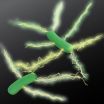(Press-News.org) AMHERST, Mass. ¬– The claim by microbiologist Derek Lovley and colleagues at the University of Massachusetts Amherst that the microbe Geobacter produces tiny electrical wires, called microbial nanowires, has been mired in controversy for a decade, but the researchers say a new collaborative study provides stronger evidence than ever to support their claims.
UMass Amherst physicists working with Lovley and colleagues report in the current issue of Nature Nanotechnology that they've used a new imaging technique, electrostatic force microscopy (EFM), to resolve the biological debate with evidence from physics, showing that electric charges do indeed propagate along microbial nanowires just as they do in carbon nanotubes, a highly conductive man-made material.
Physicists Nikhil Malvankar and Sibel Ebru Yalcin, with physics professor Mark Tuominen, confirmed the discovery using EFM, a technique that can show how electrons move through materials. "When we injected electrons at one spot in the microbial nanowires, the whole filament lit up as the electrons propagated through the nanowire," says Malvankar.
Yalcin, now at Pacific Northwest National Lab, adds, "This is the same response that you would see in a carbon nanotube or other highly conductive synthetic nanofilaments. Even the charge densities are comparable. This is the first time that EFM has been applied to biological proteins. It offers many new opportunities in biology."
Lovley says the ability of electric current to flow through microbial nanowires has important environmental and practical implications. "Microbial species electrically communicate through these wires, sharing energy in important processes such as the conversion of wastes to methane gas. The nanowires permit Geobacter to live on iron and other metals in the soil, significantly changing soil chemistry and playing an important role in environmental cleanup. Microbial nanowires are also key components in the ability of Geobacter to produce electricity, a novel capability that is being adapted to engineer microbial sensors and biological computing devices."
He acknowledges that there has been substantial skepticism that Geobacter's nanowires, which are protein filaments, could conduct electrons like a wire, a phenomenon known as metallic-like conductivity. "Skepticism is good in science, it makes you work harder to evaluate whether what you are proposing is correct," Lovley points out. "It's always easier to understand something if you can see it. Drs. Malvankar and Yalcin came up with a way to visualize charge propagation along the nanowires that is so elegant even a biologist like me can easily grasp the mechanism."
Biologists have known for years that in biological materials, electrons typically move by hopping along discrete biochemical stepping-stones that can hold the individual electrons. By contrast, electrons in microbial nanowires are delocalized, not associated with just one molecule. This is known as metallic-like conductivity because the electrons are conducted in a manner similar to a copper wire.
Malvankar, who provided the first evidence for the metallic-like conductivity of the microbial nanowires in Lovley and Tuominen's labs in 2011, says, "Metallic-like conductivity of the microbial nanowires seemed clear from how it changed with different temperature or pH, but there were still many doubters, especially among biologists."
To add more support to their hypothesis, Lovley's lab genetically altered the structure of the nanowires, removing the aromatic amino acids that provide the delocalized electrons necessary for metallic-like conductivity, winning over more skeptics. But EFM provides the final, key evidence, Malvankar says.
"Our imaging shows that charges flow along the microbial nanowires even though they are proteins, still in their native state attached to the cells. Seeing is believing. To be able to visualize the charge propagation in the nanowires at a molecular level is very satisfying. I expect this technique to have an especially important future impact on the many areas where physics and biology intersect." he adds.
Tuominen says, "This discovery not only puts forward an important new principle in biology but also in materials science. Natural amino acids, when arranged correctly, can propagate charges similar to molecular conductors such as carbon nanotubes. It opens exciting opportunities for protein-based nanoelectronics that was not possible before."
Lovley and colleagues' microbial nanowires are a potential "green" electronics component, made from renewable, non-toxic materials. They also represent a new part in the growing field of synthetic biology, he says. "Now that we understand better how the nanowires work, and have demonstrated that they can be genetically manipulated, engineering 'electric microbes' for a diversity of applications seems possible."
One application currently being developed is making Geobacter into electronic sensors to detect environmental contaminants. Another is Geobacter-based microbiological computers. This work was supported by the Office of Naval Research, the U.S. Department of Energy and the National Science Foundation.
INFORMATION:
Berlin, 19th October 2014 What's in a name? Doctors have found that the name of the drug you are prescribed significantly influences how the patient sees the treatment. Now in a significant shift, the world's major psychiatry organisations are proposing to completely change the terminology of the drugs used in mental disorders shifting it from symptom based (e.g. antidepressant, antipsychotic etc.) to pharmacologically based (e.g. focusing on pharmacological target (serotonin, dopamine etc.) and the relevant mode of action). This will mean that patient will no longer have ...
Scientists at The University of Manchester hope a major breakthrough could lead to more effective methods for detoxifying dangerous pollutants like PCBs and dioxins. The result is a culmination of 15 years of research and has been published in Nature. It details how certain organisms manage to lower the toxicity of pollutants.
The team at the Manchester Institute of Biotechnology were investigating how some natural organisms manage to lower the level of toxicity and shorten the life span of several notorious pollutants.
Professor David Leys explains the research: ...
Kansas City, MO - While megakaryocytes are best known for producing platelets that heal wounds, these "mega" cells found in bone marrow also play a critical role in regulating stem cells according to new research from the Stowers Institute for Medical Research. In fact, hematopoietic stem cells differentiate to generate megakaryocytes in bone marrow. The Stowers study is the first to show that hematopoietic stem cells (the parent cells) can be directly controlled by their own progeny (megakaryocytes).
The findings from the lab Stowers Investigator Linheng Li, Ph.D., described ...
At least 2 percent of people over age 40 and 5 percent of people over 70 have mutations linked to leukemia and lymphoma in their blood cells, according to new research at Washington University School of Medicine in St. Louis.
Mutations in the body's cells randomly accumulate as part of the aging process, and most are harmless. For some people, genetic changes in blood cells can develop in genes that play roles in initiating leukemia and lymphoma even though such people don't have the blood cancers, the scientists report Oct. 19 in Nature Medicine.
The findings, based ...
CHICAGO – Oct. 19, 2014 – The first tear duct implant developed to treat inflammation and pain following cataract surgery has been shown to be a reliable alternative to medicated eye drops, which are the current standard of care, according to a study presented today at AAO 2014, the 118th annual meeting of the American Academy of Ophthalmology. The device, known as a punctum plug, automatically delivers the correct amount of postoperative medication in patients, potentially solving the issue of poor compliance with self-administering eye drops.
After cataract ...
BETHESDA, MD – A child's genetic makeup may contribute to his or her mother's risk of rheumatoid arthritis, possibly explaining why women are at higher risk of developing the disease than men. This research will be presented Tuesday, October 21, at the American Society of Human Genetics (ASHG) 2014 Annual Meeting in San Diego.
Rheumatoid arthritis, a painful inflammatory condition that primarily affects the joints, has been tied to a variety of genetic and environmental factors, including lifestyle factors and previous infections. Women are three times more likely ...
BETHESDA, MD – Scientists studying birth defects in humans and purebred dogs have identified an association between cleft lip and cleft palate – conditions that occur when the lip and mouth fail to form properly during pregnancy – and a mutation in the ADAMTS20 gene. Their findings were presented today at the American Society of Human Genetics (ASHG) 2014 Annual Meeting in San Diego.
"These results have potential implications for both human and animal health, by improving our understanding of what causes these birth defects in both species," said Zena ...
Geneva, Switzerland – 19 October 2014: Women are more likely to develop anxiety and depression after a heart attack (myocardial infarction; MI) than men, according to research presented at Acute Cardiovascular Care 2014 by Professor Pranas Serpytis from Lithuania.
Acute Cardiovascular Care is the annual meeting of the Acute Cardiovascular Care Association (ACCA) of the European Society of Cardiology (ESC) and takes place 18-20 October in Geneva, Switzerland.
Professor Serpytis said: "The World Health Organization predicts that by 2020 depression will be the second ...
BETHESDA, MD – Human geneticists have discovered that a region of the genome associated with autism contains genetic variation that evolved in the last 250,000 years, after the divergence of humans from ancient hominids, and likely plays an important role in disease. Their findings were presented today at the American Society of Human Genetics (ASHG) 2014 Annual Meeting in San Diego.
Researchers at the University of Washington analyzed the genomes of 2,551 humans, 86 apes, one Neanderthal, and one Denisovan. They closely examined a region of human chromosome 16 ...
Berlin, 19th October 2014 All humans have a natural opioid system in the brain. Now new research, presented at the ECNP Congress in Berlin, has found that the opioid system of pathological gamblers responds differently to those of normal healthy volunteers. The work was carried out by a group of UK researchers from London and Cambridge, and was funded by the Medical Research Council. This work is being presented at the European College of Neuropsychopharmacology congress in Berlin.
Gambling is a widespread behaviour with about 70% of the British population gambling occasionally. ...



